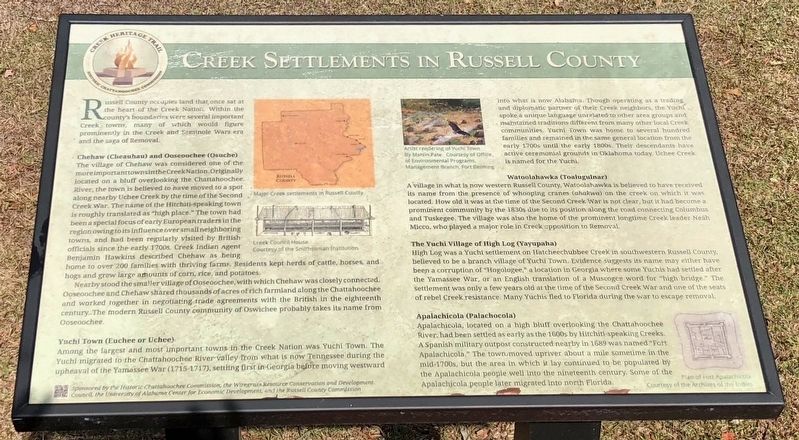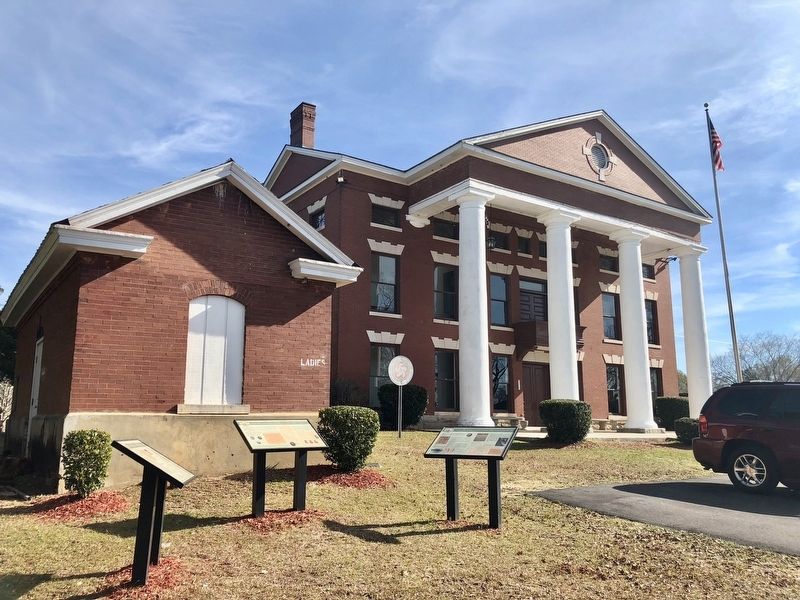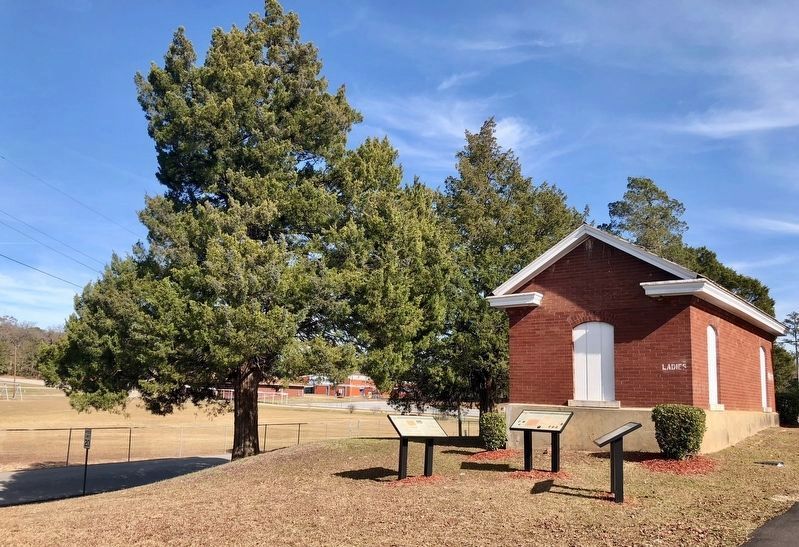Seale in Russell County, Alabama — The American South (East South Central)
Creek Settlements in Russell County
— Creek Heritage Trail —
Chehaw (Cheauhau) and Ooseoochee (Osuche)
The village of Chehaw was considered one of the more important towns in the Creek Nation. Originally located on a bluff overlooking the Chattahoochee River, the town is believed to have moved to a spot along nearby Uchee Creek by the time of the Second Creek War. The name of the Hitchiti-speaking town is roughly translated as "high place." The town had been a special focus of early European traders in the region owing to its influence over small neighboring towns, and had been regularly visited by British officials since the early 1700s. Creek Indian Agent Benjamin Hawkins described Chehaw as being home to over 200 families with thriving farms. Residents kept herds of cattle, horses and hogs grew large amounts of corn, rice, and potatoes.
Nearby stood the smaller village of Ooseoochee, with which Chehaw was closely connected. Ooseoochee and Chehaw shared thousands of acres of rich farmland along the Chattahoochee and worked together in negotiating trade agreements with the British in the eighteenth century. The modern Russell County community of Oswichee probably takes its name from Ooseoochee.
Yuchi Town (Euchee or Uchee)
Among the largest and most important towns in the Creek Nation was Yuchi Town. The Yuchi migrated to the Chattahoochee River-valley from what is now Tennessee during the upheaval of the Yamassee War (1715-1717), settling first in Georgia before moving westward into what is now Alabama. Though operating as a trading and diplomatic partner of their Creek neighbors, the Yuchí spoke a unique language unrelated to other area groups and maintained traditions different from many other local Creek communities, Yuchi Town was home to several hundred families and remained in the same general location from the early 1700s until the early 1800s. Their descendants have active ceremonial grounds in Oklahoma today. Uchee Creek is named for the Yuchi.
Watoolahawka (Toalugulnar)
A village in what is now western Russell County, Watoolahawka is believed to have received its name from the presence of whooping cranes (ahakwa) on the creek on which it was located. How old it was at the time of the Second Creek War is not clear, but it had become a prominent community by the 1830s due to its position along the road connecting Columbus and Tuskegee. The village was also the home of the prominent longtime Creek leader Neah Micco, who played a major role
in Creek opposition to Removal.
The Yuchi Village of High Log (Yayupaha)
High Log was a Yuchi settlement on Hatcheechubbee Creek in southwestern Russell County, believed to be a branch village of Yuchi Town. Evidence suggests its name may either have been a corruption of "Hogologee," a location in Georgia where some Yuchis had settled after the Yamassee War, or an English translation of a Muscogee word for "high bridge." The settlement was only a few years old at the time of the Second Creek War and one of the seats of rebel Creek resistance. Many Yuchis fled to Florida during the war to escape removal.
Apalachicola (Palachocola)
Apalachicola, located on a high bluff overlooking the Chattahoochee River, had been settled as early as the 1600s by Hitchiti-speaking Creeks. A Spanish military outpost constructed nearby in 1689 was named "Fort Apalachicola." The town moved upriver about a mile sometime in the mid-1700s, but the area in which it lay continued to be populated by the Apalachicola people well into the nineteenth century, Some of the Apalachicola people later migrated into north Florída.
Photo captions
Left middle: Major Creek settlements in Russell County
Creek Council House
Right middle: Artist rendering of Yuchi Town Right bottom: Plan of Fort Apalachicola
Erected 2015 by the Historic Chattahoochee Commission, the Wiregrass Resource Conservation and Development Council, the University of Alabama Center for Economic Development, and the Russell County Commission.
Topics. This historical marker is listed in these topic lists: Forts and Castles • Native Americans • Settlements & Settlers • Wars, US Indian. A significant historical year for this entry is 1689.
Location. 32° 17.906′ N, 85° 10.06′ W. Marker is in Seale, Alabama, in Russell County. Marker is at the intersection of Longview Street and Jackson Street, on the right when traveling north on Longview Street. Located on the grounds of the Old Russell County Courthouse. Touch for map. Marker is at or near this postal address: 91 Longview Street, Seale AL 36875, United States of America. Touch for directions.
Other nearby markers. At least 8 other markers are within 3 miles of this marker, measured as the crow flies. The Second Creek War in Russell County (here, next to this marker); Early Russell County and the Town of Seale (here, next to this marker); Old Russell County Courthouse (a few steps from this marker); Seale United Methodist Church (about 500 feet away, measured in a direct line); Holland McTyeire Smith (approx. ¼ mile away); John Bacon McDonald (approx. half a mile away); William Bacon Oliver (approx. 1.2 miles away); The Old Federal Road (approx. 2.1 miles away). Touch for a list and map of all markers in Seale.
Also see . . . Native American History of Russell County, Alabama. (Submitted on December 17, 2017, by Mark Hilton of Montgomery, Alabama.)
Credits. This page was last revised on December 17, 2017. It was originally submitted on December 17, 2017, by Mark Hilton of Montgomery, Alabama. This page has been viewed 1,043 times since then and 130 times this year. Photos: 1, 2, 3. submitted on December 17, 2017, by Mark Hilton of Montgomery, Alabama.


